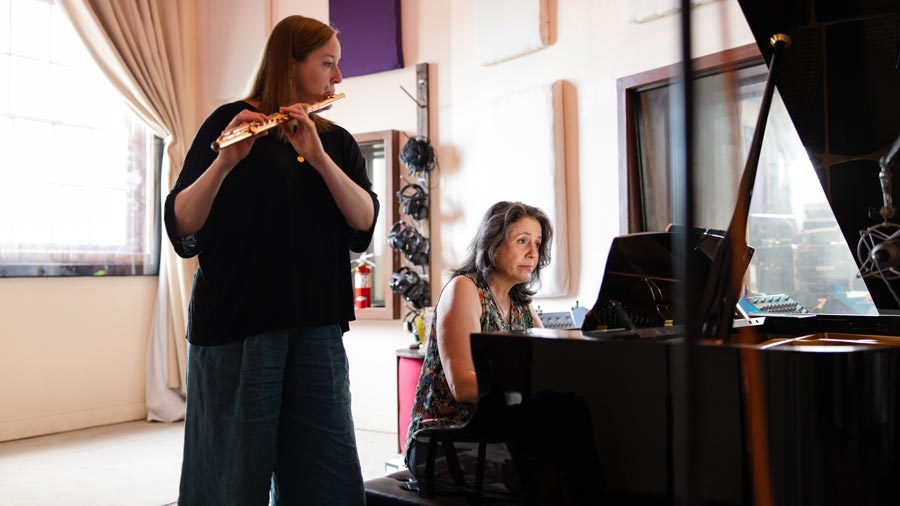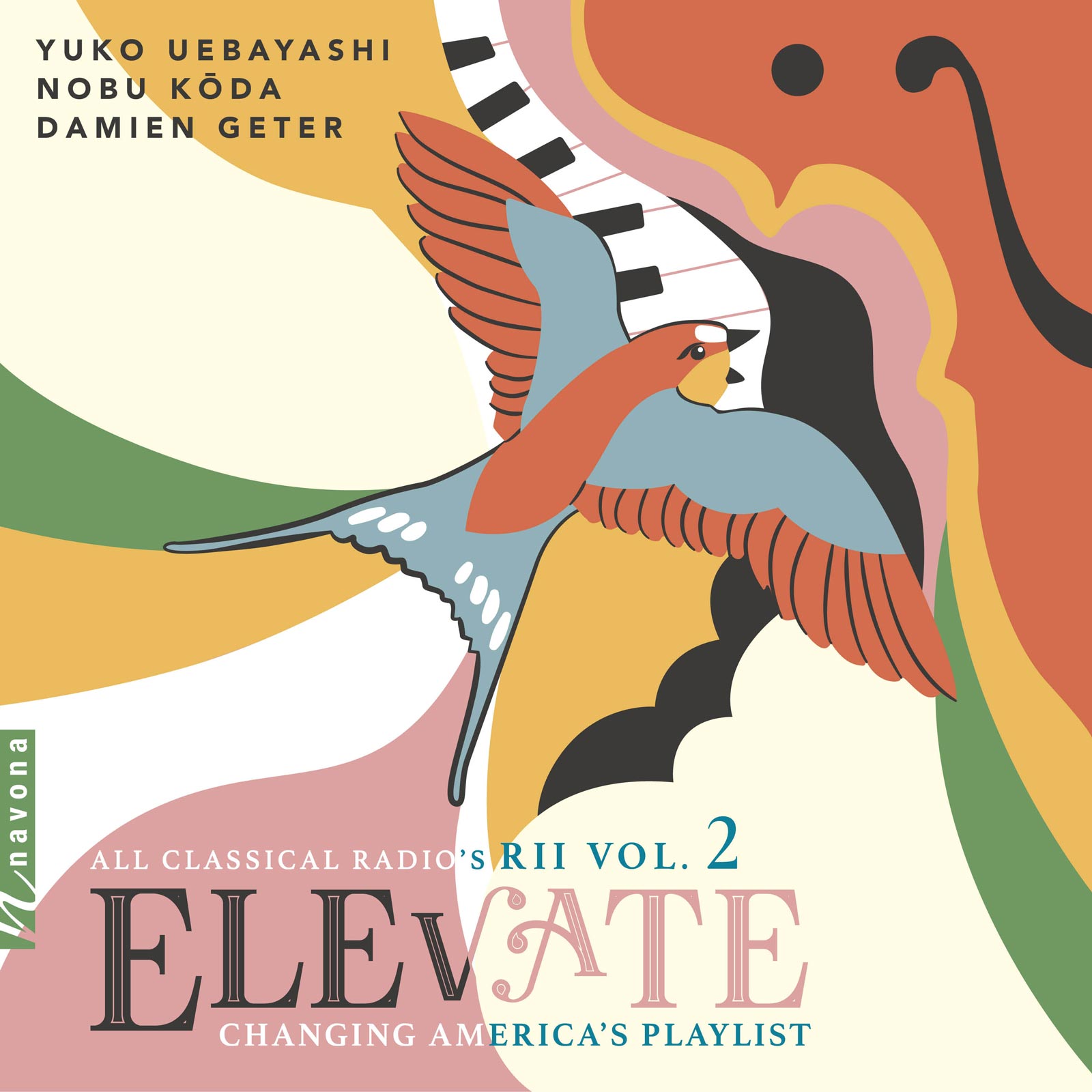ELEVATE: the second installment of All Classical Radio’s award-winning Recording Inclusivity Initiative.
Bringing to life the sonatas of Yuko Uébayashi and Nobu Kōda and a string quartet by Damien Geter, ELEVATE pairs deserving compositional talent with several of today’s leading classical performers — a synergetic testament to the power of uplifting each other in the arts.
Today, ELEVATE performers María Garcia and Martha Long join us on the “Inside Story,” a blog series exploring the inner workings and personalities of our artists. Read on to learn what they discovered in bringing Yuko Uébayashi’s piece to life, and what they hope listeners will find in this groundbreaking release…
All Classical Radio’s Recording Inclusivity Initiative is a landmark effort in presenting the works of underrepresented composers to a wider network of audiences. How does it feel to be a part of this initiative, and how might you recommend that presenters of classical music take similar measures in unearthing and showcasing these works?
María Garcia: It is a remarkable opportunity to be a part (now for a second time!) of All Classical’s groundbreaking Recording Inclusivity Initiative. Classical music has a long history of primarily highlighting white male composers throughout the centuries, with women and minority composers usually underrepresented. All Classical Radio is leading the way into a brighter and more inclusive future by producing recordings of underrepresented composers (both deceased and living). The initiative is a great model that should be adapted by other broadcasting stations and musical organizations seeing themselves as co-creators and stewards of a new paradigm where a wider range of voices are included creating a more vibrant and inclusive classical music scene.
Martha Long: It is an honor to be part of this project and to be able to bring a piece that I love to a larger audience.
Sonata for Flute and Piano’s liner notes state that it “offers a challenging, albeit rewarding, opportunity to explore the composer’s evocative musical language.” In what ways do you feel you were rewarded in performing this piece? Did it reveal anything in particular?
María Garcia: Yuko Uebayashi composes primarily for flute and woodwind instruments, and as a pianist I had never come across her works. When my friend and colleague Martha Long asked me to learn and perform the piece, I remember first being surprised at the scope of the piece. It is a large scope Sonata in four movements and its piano writing is very technically demanding with each movement creating a unique musical statement. I likened it somewhat to the scope of another remarkable Flute and Piano Sonata (Prokofiev) which is also in four movements. As I dove into the process of learning it, I was continuously impressed by the excellent writing.
Although the general style of the work could be said to be reminiscent or influenced by the French Classical/Impressionistic/Contemporary style, it also has tinges of what I perceive (as a non-Japanese person) to be Eastern influences and Uebayashi certainly creates a unique voice. Pedaling, fingering, phrasing, texture, exchange of musical ideas between the flute and the piano, balance, voicing, harmonic language, and arc of story are some of the challenges presented in the process of learning this work. It was a treat to work with someone as skilled and inspiring as Martha.
Martha Long: Uebayashi’s musical language is a fresh take on classical forms. She uses the standard sonata form yet imbues it with colorful harmonies, sweeping melodies, and exciting characters.
How do you hope audiences will respond to the works on ELEVATE? What do you want them to take away after listening to this album?
María Garcia: Classical music can be often exclusively associated with a very narrow list of “great composers” that roll off of everyone’s lips: Mozart, Beethoven, Bach, Prokofiev, Chopin, Debussy to name but a few. As a Latin American woman, as a musician, as the mother of a young daughter, I would like this recording to expand the general perception and conversation of what classical music is.
Martha Long: I hope that audiences love listening to these pieces as much as we love performing them, and that they are excited to hear more of Uebayashi’s music and works of other contemporary classical composers afterwards.
How might your interpretation or approach to these works differ from your approach to more mainstream classical music repertoire?
María Garcia: All music is music. I always say there’s only two types of music: good music or bad music. Now… bad music is all a matter of perception and we may all have different ideas on what that is. But nevertheless music is about the relationship between sounds, how sounds and rhythms can be combined to create a musical impression (some would say a story) that is unique to the composer as they create and notate it into music manuscript, extending then to the performer as they learn and present it, and furthermore to each listener as they take it into their ears, hearts, and minds. As performers of a composer’s work, when learning a musical composition we often consider time period, original instrument (as in fortepiano or harpsichord vs. modern piano), general agreed upon stylistic choices for the time, musical notation, etc… With pieces that are lesser known or newer within the greater collective one could say that there is somewhat more freedom in making musical choices because perhaps there’s not such an overwhelming agreement on the style. All composers have tools which help convey their intention such as meter, harmony, tempo markings, notation, articulations, all which help inform the performer in their learning journey. Unless one gets to play in person for a composer as one learns a work, it is often about the choices we make based on these factors, combined with our preferences, style, personality, etc… Regardless of time period whether old or new, music is ultimately about combining all of these elements and bringing a piece to life.
Martha Long: For this piece, my approach was the same as when I learn any other sonata. This piece follows in the footsteps of the great 20th century flute sonatas, especially the masterpiece by Sergei Prokofiev. To me, it feels like a natural successor to the Prokofiev Sonata and I hope that it gains that foothold and gravitas among other masterworks of the sonata repertoire.
Uebayashi is becoming well-known to flute players all over the globe for her extensive catalog of works that are simultaneously expressive, technically demanding, and approachable for all audiences. To bring her masterpiece, the Sonata for Flute and Piano, to a larger audience is an honor. María and I had a fantastic time learning this piece and discovering its many fascinating colors, harmonies, dialogues, and characters. Uebayashi’s writing presented numerous technical challenges for both of us that, in the end, made us better players. Yet the musical content of this piece is incredibly deep and meaningful and it supersedes any and all technical concerns. This is a testament to Uebayashi’s musical craft — that she can both understand and transcend the technical demands of several instruments, creating a musical narrative that is incredibly rewarding both to play and to listen to. For me, this is the first great flute sonata of the 21st century, following in the footsteps of Sergei Prokofiev’s Flute Sonata in D Major and other great works of chamber music, like Johannes Brahms’s Sonatas for Clarinet or Viola. It has equal heft, gravitas, importance, and — I hope — longevity.
What characteristics of the composers on ELEVATE do you believe are entirely unique to them? Is there an intrinsic quality to their music that you believe cannot be found elsewhere?
María Garcia: I love the works on this album and how it presents the music of two Japanese women (one living, one deceased) and the music of a younger generation African American living composer. Each work represents the person who created the art, their journey, it speaks to the time, to the influences and reflects on our collective story. In essence they are as unique as their individuals and expands the canon available to our present and future generations of classical music listeners and performers.
Original post: https://www.navonarecords.com/news/inside-story-elevate/
ELEVATE
Available now from Navona Records.







